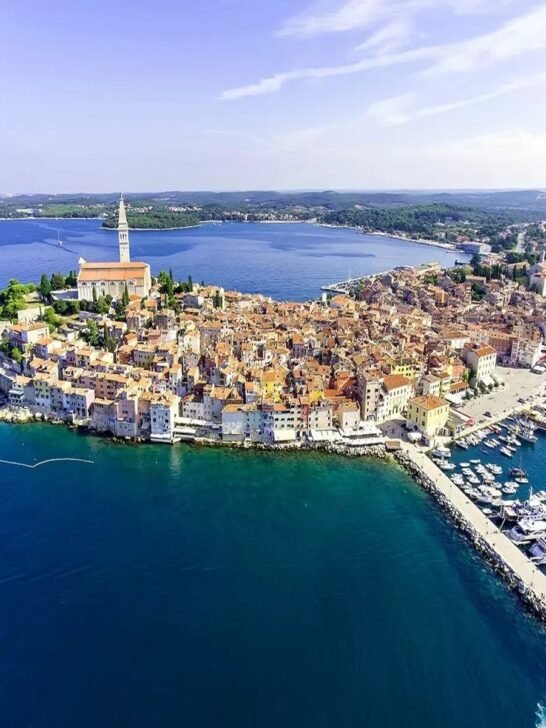Pula, the largest city in Croatia’s Istrian Peninsula, is a captivating blend of history, natural beauty, and coastal charm. Known for its remarkably preserved Roman ruins, crystal-clear waters, and vibrant culinary scene, Pula offers something for every traveler. Whether you’re a history buff, a beach lover, or an adventurer, this travel guide will help you explore the best things to do in Pula, Croatia.
Things to Do in Pula, Croatia
Table Of Content
This blog contains affiliate links, which means I may earn a commission if you make a purchase through these links, at no additional cost to you.
1. Explore the Pula Arena: A Roman Marvel

No visit to Pula is complete without exploring the iconic Pula Arena. This ancient amphitheater, dating back to the 1st century AD, is one of the best-preserved Roman structures in the world. Once a venue for gladiatorial battles, today it hosts concerts, festivals, and even film screenings. Walking through the amphitheater’s stone corridors offers a glimpse into the grandeur of the Roman Empire.
The Pula Arena, one of Croatia’s most iconic landmarks, is a breathtaking example of ancient Roman engineering and architectural mastery. Situated in the heart of Pula, this remarkably well-preserved amphitheater stands as a testament to the grandeur of the Roman Empire. Whether you are a history enthusiast, an architecture admirer, or simply a traveler seeking an unforgettable experience, visiting the Pula Arena is a must.
A Glimpse into History
Constructed between 27 BC and 68 AD during the reign of Emperor Vespasian, the Pula Arena is among the six largest surviving Roman amphitheaters in the world. Originally built for gladiatorial contests and public spectacles, it could accommodate up to 23,000 spectators. Unlike many ancient structures, the arena has remained largely intact over the centuries, making it one of the most complete Roman amphitheaters still standing today.
Architectural Grandeur
The Pula Arena is an impressive feat of engineering, featuring an elliptical structure with limestone walls that soar to a height of 32.5 meters. Its outer walls are adorned with 72 arched openings, creating a striking visual effect. The arena’s underground chambers, once used to house animals and gladiators before battles, add another layer of intrigue to its storied past. Walking through these corridors transports visitors back to an era of fierce combat and grand spectacles.
Modern-Day Events and Cultural Significance
While the days of gladiatorial combat are long gone, the Pula Arena remains a vibrant cultural hub. Today, it serves as a premier venue for concerts, film screenings, and festivals. The Pula Film Festival, one of Croatia’s most prestigious cinematic events, is held here annually, drawing filmmakers and audiences from around the world. Additionally, renowned musicians and artists have graced the arena’s stage, transforming this ancient marvel into a dynamic entertainment space.
What to Expect When Visiting
Visitors can explore the arena at their own pace or join guided tours that offer deeper insights into its history and construction. Exhibits within the amphitheater showcase artifacts, including weapons and tools used during its heyday. For a truly immersive experience, try visiting during sunset when the golden light accentuates the arena’s majestic beauty.
Discover unbeatable hotel deals for your next adventure—compare prices and book your perfect stay effortlessly on our platform today!
2. Stroll Through the Old Town and Visit the Forum
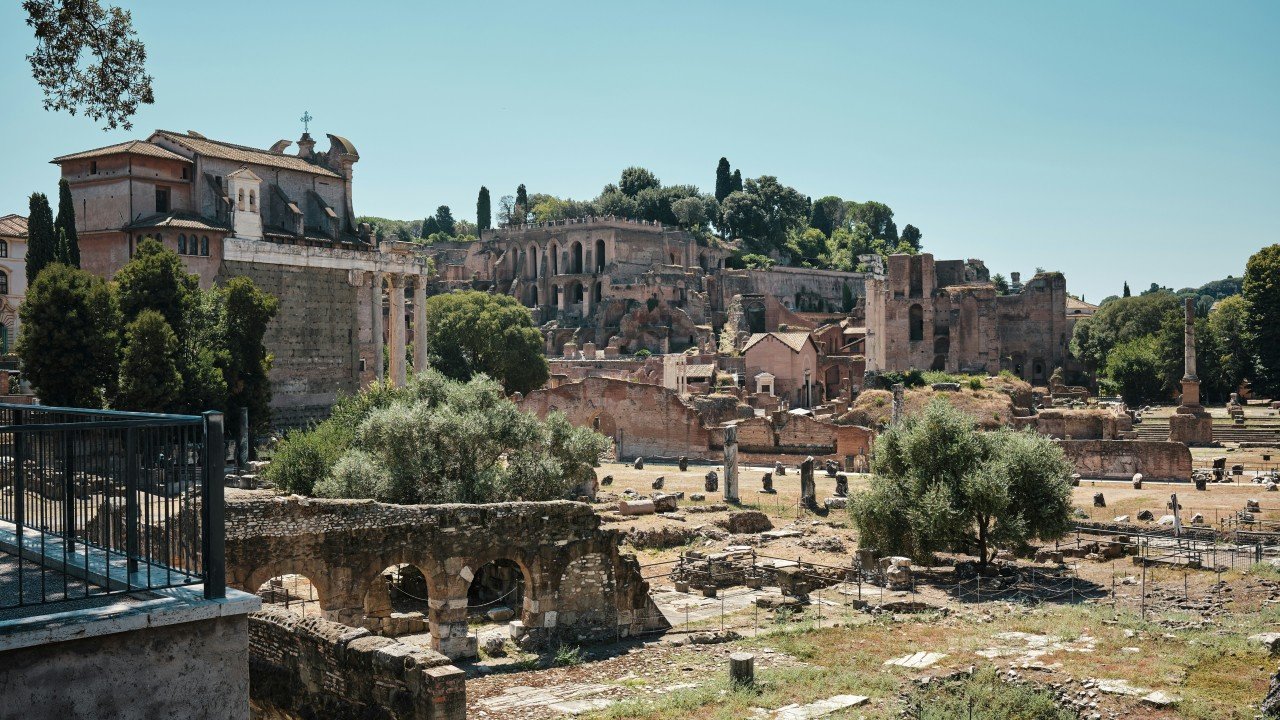
Pula’s Old Town is a maze of cobblestone streets lined with historic buildings, charming cafés, and lively squares. The Forum, the city’s central square since Roman times, is home to the Temple of Augustus. This well-preserved temple stands as a testament to the city’s rich past and is a must-see for history enthusiasts.
Pula, a city rich in history and charm, offers visitors an opportunity to step back in time while exploring its picturesque Old Town. With its cobbled streets, centuries-old architecture, and lively squares, Pula’s Old Town is a must-visit destination for anyone eager to experience the city's cultural and historical essence. At the heart of this historic area lies the Forum, the city’s ancient main square, which continues to be a vibrant hub of activity today.
Discovering Pula’s Old Town
Wandering through the Old Town of Pula is like walking through an open-air museum. The narrow, winding streets are lined with traditional Istrian houses, colorful façades, and charming cafés, creating a warm and inviting atmosphere. As you explore, you’ll come across hidden courtyards, quaint local shops, and historic landmarks that tell the story of Pula’s rich past. The blend of Roman, Venetian, and Austro-Hungarian influences is evident in the architecture, making every turn a visual delight.
One of the highlights of the Old Town is the Kastel, a Venetian fortress perched on a hill overlooking the city. From here, you can enjoy panoramic views of Pula and the shimmering Adriatic Sea. The fortress itself houses the Historical and Maritime Museum of Istria, offering insights into the region’s fascinating past.
The Forum: Pula’s Historic Heart
At the center of the Old Town lies the Forum, Pula’s main square since Roman times. This grand plaza was once the political, social, and religious center of the city, where citizens gathered for debates, celebrations, and administrative affairs. Today, the Forum remains a lively meeting point, surrounded by historic buildings, bustling cafés, and restaurants where locals and visitors alike enjoy the relaxed atmosphere.
Temple of Augustus: A Roman Masterpiece
The most iconic landmark in the Forum is the Temple of Augustus, a remarkably well-preserved Roman temple dedicated to Emperor Augustus. Built in the 1st century AD, this magnificent structure is one of the few surviving Roman temples in the world. The temple now houses a small museum featuring ancient Roman sculptures and artifacts, offering a glimpse into Pula’s rich Roman heritage.
The City Hall: A Blend of Eras
Another striking building in the Forum is the City Hall, which showcases a fascinating mix of architectural styles. Originally constructed in the 13th century, the structure incorporates elements from different historical periods, including Roman inscriptions, Gothic windows, and Renaissance details. It stands as a testament to Pula’s layered history and evolving urban landscape.
A Perfect Blend of History and Modern Life
While the Forum is steeped in history, it is also a lively and dynamic space where visitors can enjoy a cup of coffee at an outdoor café, watch street performances, or experience local festivals. The square is especially enchanting in the evening when the historic buildings are illuminated, creating a magical ambiance.
Find the best hotel deals for your next trip—compare prices from top sites and book your perfect stay all in one place!
3. Visit the Arch of the Sergii and Twin Gates
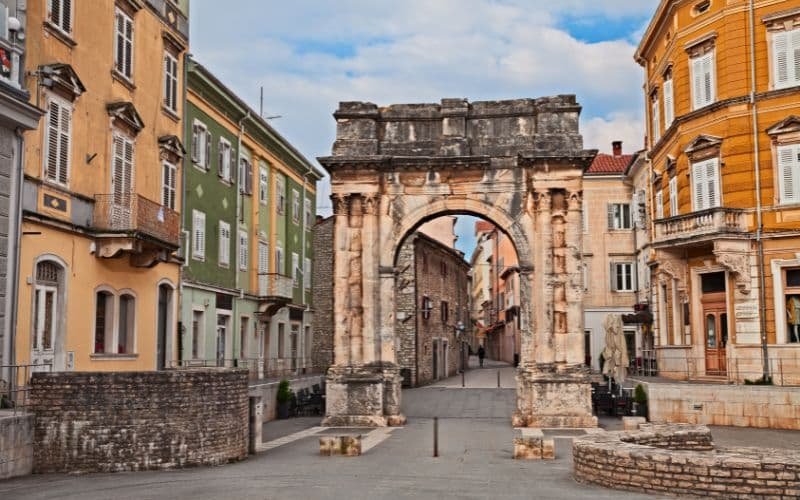
Another testament to Pula’s Roman heritage is the Arch of the Sergii, a triumphal arch built in the 1st century BC. It marks the entrance to the city and is one of the most photographed landmarks in Pula. Nearby, the Twin Gates are another ancient relic that once formed part of the city’s defensive walls.
The Arch of the Sergii: A Triumphal Symbol
One of Pula’s most iconic historical structures, the Arch of the Sergii, is a triumphal arch built in the late 1st century BC to commemorate the powerful Sergii family, who played a prominent role in the political and military life of the Roman Empire. This magnificent arch once marked the entrance to the city and stood as a symbol of victory and prestige.
Crafted from local limestone, the arch showcases intricate Corinthian-style columns, beautifully carved friezes, and detailed reliefs depicting mythological and military motifs. Over the centuries, it has remained remarkably well-preserved, standing as a testament to Roman craftsmanship and artistic excellence. Today, it serves as a popular meeting point for both locals and visitors, providing a striking backdrop for photos and historical reflection.
Twin Gates: A Glimpse into Pula’s Defensive Walls
Just a short walk from the Arch of the Sergii, the Twin Gates (Porta Gemina) offer another fascinating insight into Pula’s Roman heritage. These double-arched stone gates were once part of the city's defensive walls, serving as one of the primary entrances to ancient Pula.
Dating back to the 2nd century AD, the Twin Gates are characterized by their symmetrical arches and robust construction. Though much of Pula’s fortifications were dismantled over the centuries, these gates have endured, standing as a reminder of the city's once formidable defenses. Today, they provide an entrance to the Archaeological Museum of Istria, where visitors can explore a wealth of artifacts and historical exhibits that further illuminate Pula’s Roman past.
Experiencing Pula’s Roman Legacy
Visiting the Arch of the Sergii and Twin Gates offers more than just an appreciation of architectural beauty—it’s a journey through time. Strolling between these ancient structures, one can imagine the bustling streets of Roman Pula, where merchants, soldiers, and citizens once passed through these grand gateways.
For a truly immersive experience, consider visiting in the evening when the arch is beautifully illuminated, enhancing its majestic presence. Nearby, you’ll find charming cafés and vibrant streets where you can sit and soak in the historical atmosphere of Pula.
Find the best hotel deals for your next trip—compare prices across top travel sites and book your ideal stay instantly on [travelbloger.net]!
4. Discover Pula’s Underground Tunnels: Zerostrasse
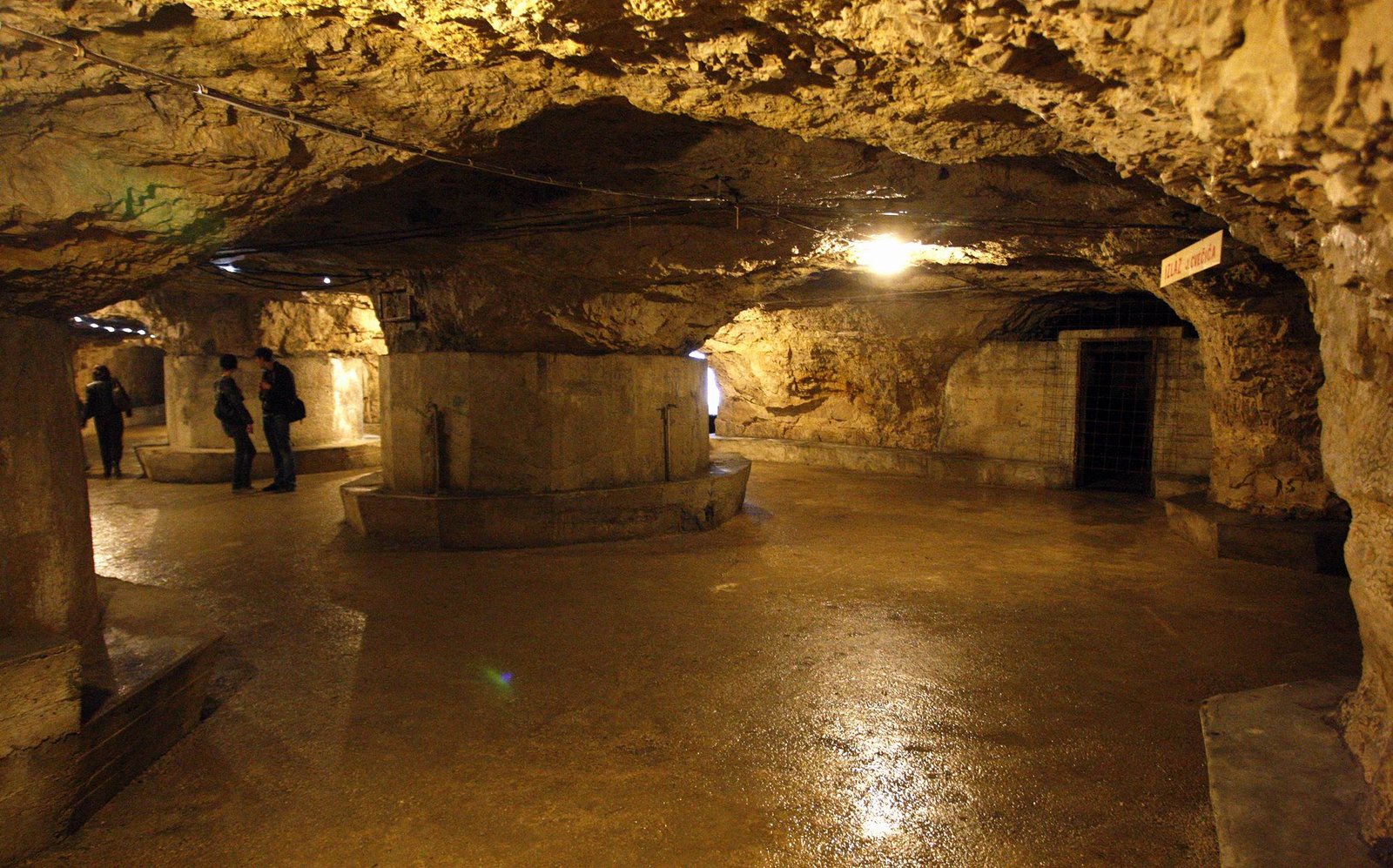
Beneath the city lies Zerostrasse, an extensive network of tunnels built during World War I to provide shelter during air raids. Today, these tunnels serve as a fascinating historical attraction and often host exhibitions. Walking through them gives visitors a unique perspective on Pula’s strategic military significance.
Beneath the bustling streets of Pula lies a hidden world of intrigue and history—the Zerostrasse, an extensive network of underground tunnels that offers a unique glimpse into the city's military past. Built during World War I as a strategic defense system, these subterranean passageways now serve as a fascinating attraction for visitors eager to explore Pula’s lesser-known historical gems.
A Legacy of War and Protection
The Zerostrasse tunnels were constructed by the Austro-Hungarian Empire in the early 20th century when Pula was a major naval base. Designed as air-raid shelters to protect soldiers and civilians from bombings, these underground corridors could accommodate thousands of people. Over the years, the tunnels continued to serve various military and civilian functions, reflecting Pula’s strategic significance in European history.
Today, the tunnels have been preserved and repurposed as an exhibition space, offering visitors an opportunity to walk through history and experience the eerie yet captivating atmosphere of this underground labyrinth.
Exploring the Underground Passageways
The Zerostrasse tunnels stretch beneath Pula’s Old Town and lead to several key locations, including the Kastel fortress, which sits atop the city’s central hill. As you wander through the dimly lit corridors, you’ll notice the vastness of the network, with passageways stretching in multiple directions, some leading to hidden chambers and bunkers.
One of the highlights of visiting Zerostrasse is the historical exhibitions displayed within the tunnels. These exhibits feature archival photographs, wartime artifacts, and detailed accounts of Pula’s role during various conflicts. The cool, damp air and echoing footsteps create an immersive experience that transports visitors back in time.
A Unique Perspective on Pula’s History
Unlike Pula’s more famous landmarks, such as the Roman Arena or the Arch of the Sergii, Zerostrasse offers a different kind of historical exploration—one that delves beneath the surface to reveal the city’s wartime resilience and strategic importance. It’s a must-visit for history enthusiasts, urban explorers, and anyone curious about the hidden layers of Pula’s past.
Practical Information for Visitors
- Location: The entrance to the Zerostrasse tunnels is near the base of Kastel Fortress.
- Opening Hours: Hours may vary depending on the season, so it’s recommended to check in advance.
- Best Time to Visit: Due to the naturally cool temperature of the tunnels, visiting during the summer months provides a refreshing escape from the heat.
- Accessibility: The tunnels are generally easy to navigate, but some areas may have uneven terrain.
Looking for budget-friendly flights or all-in-one travel packages? Check out our top picks and start planning your perfect getaway today!
5. Enjoy Pula’s Stunning Beaches
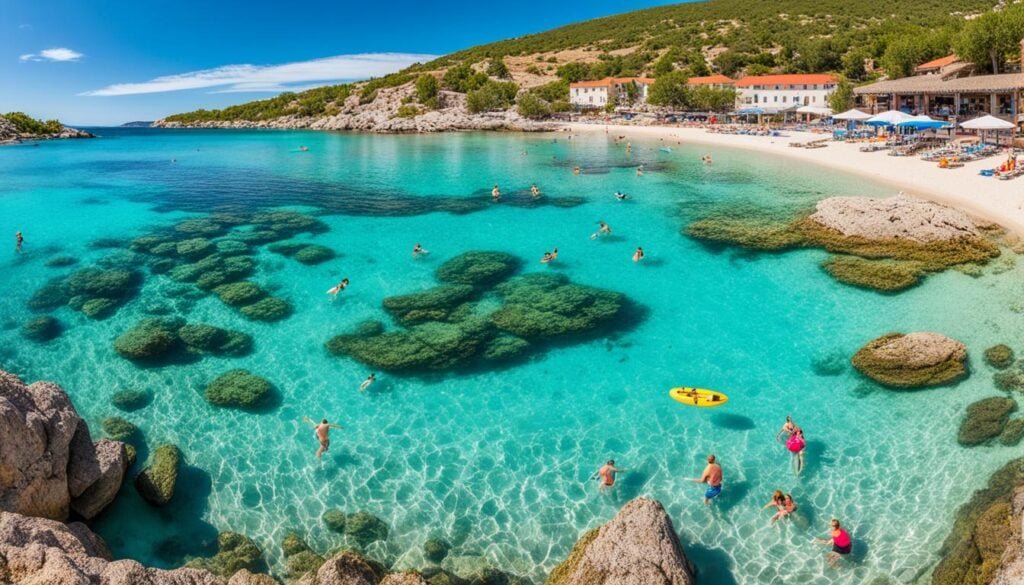
Pula boasts some of the most picturesque beaches in Croatia. Head to Verudela Peninsula, where you’ll find Hawaii Beach, known for its turquoise waters and dramatic cliffs. Ambrela Beach is perfect for families, with its shallow waters and pebble shoreline, while Valkane Beach offers accessibility features for all visitors.
Pula, a captivating coastal gem in Croatia’s Istrian Peninsula, is not only rich in history but also blessed with some of the most stunning beaches along the Adriatic Sea. Whether you’re looking for a peaceful retreat, crystal-clear waters, or vibrant beachside activities, Pula offers an idyllic escape for every type of traveler. From hidden coves to lively beach resorts, here’s a guide to some of the best beaches in Pula where you can soak up the sun and enjoy the beauty of the Mediterranean.
Ambrela Beach: A Family-Friendly Haven
Located within Verudela Resort, Ambrela Beach is a Blue Flag-awarded beach known for its clean waters and well-maintained facilities. With its gentle pebbled shore and shallow, calm waters, it’s the perfect spot for families with young children. Sun loungers and parasols are available for rent, and nearby cafés and restaurants provide refreshments, making it an excellent place for a relaxing day by the sea.
Hawaiian Beach: A Scenic Natural Wonder
For those seeking a more adventurous beach experience, Hawaiian Beach offers breathtaking scenery with its rugged coastline, crystal-clear waters, and smooth white pebbles. Popular among young travelers and thrill-seekers, this beach is known for its cliffs, which provide excellent spots for diving into the refreshing Adriatic. The turquoise waters and stunning rock formations make it a picture-perfect location for nature lovers and photographers alike.
Valkane Beach: A Blend of Relaxation and Activity
Valkane Beach is a well-equipped beach close to Pula’s city center, making it an easily accessible destination for both locals and tourists. It features a combination of pebbles and concrete sunbathing areas, catering to different preferences. Valkane is also a great choice for those who enjoy water sports, with activities such as paddleboarding, kayaking, and beach volleyball available. The nearby promenade is lined with cafés and bars, offering a great spot to unwind with a refreshing drink while overlooking the sea.
Histria Beach: A Luxurious Escape
Situated in the Park Plaza Histria Resort, Histria Beach offers a more upscale beach experience. The well-maintained pebble and rocky beach boasts crystal-clear waters and high-end amenities, including sun loungers, beachside bars, and a selection of water activities. With its tranquil atmosphere and stunning sea views, Histria Beach is an ideal spot for couples and travelers looking for a more refined beach day.
Gortanova Uvala: A Local Favorite
Nestled between Valkane and Valsaline beaches, Gortanova Uvala is a small, picturesque bay loved by locals. Surrounded by lush Mediterranean pine trees, it provides natural shade and a serene escape from the city’s hustle and bustle. The beach features pebbles and shallow waters, making it an excellent choice for swimming and snorkeling. As the sun sets, the golden glow reflecting on the water creates a truly magical ambiance.
Seagull’s Rocks: A Paradise for Adventurers
For the most adventurous beachgoers, Seagull’s Rocks (Galebove Stijene) is a must-visit. Located within Punta Christo, this beach is famous for its dramatic cliffs and deep blue waters, making it an ideal spot for cliff diving and snorkeling. The rugged surroundings provide a sense of seclusion, perfect for those looking to explore a more untouched and wild side of Pula’s coastline.
Tips for Enjoying Pula’s Beaches
- Bring water shoes: Many of Pula’s beaches are pebbly or rocky, so water shoes can make your experience more comfortable.
- Stay hydrated: The summer sun can be intense, so keep a bottle of water handy.
- Respect nature: Many of Pula’s beaches are surrounded by pristine natural landscapes—be sure to clean up after yourself and preserve the beauty of the area.
- Arrive early: Popular beaches can get crowded during peak season, so visiting in the morning allows for a more peaceful experience.
6. Experience Brijuni National Park
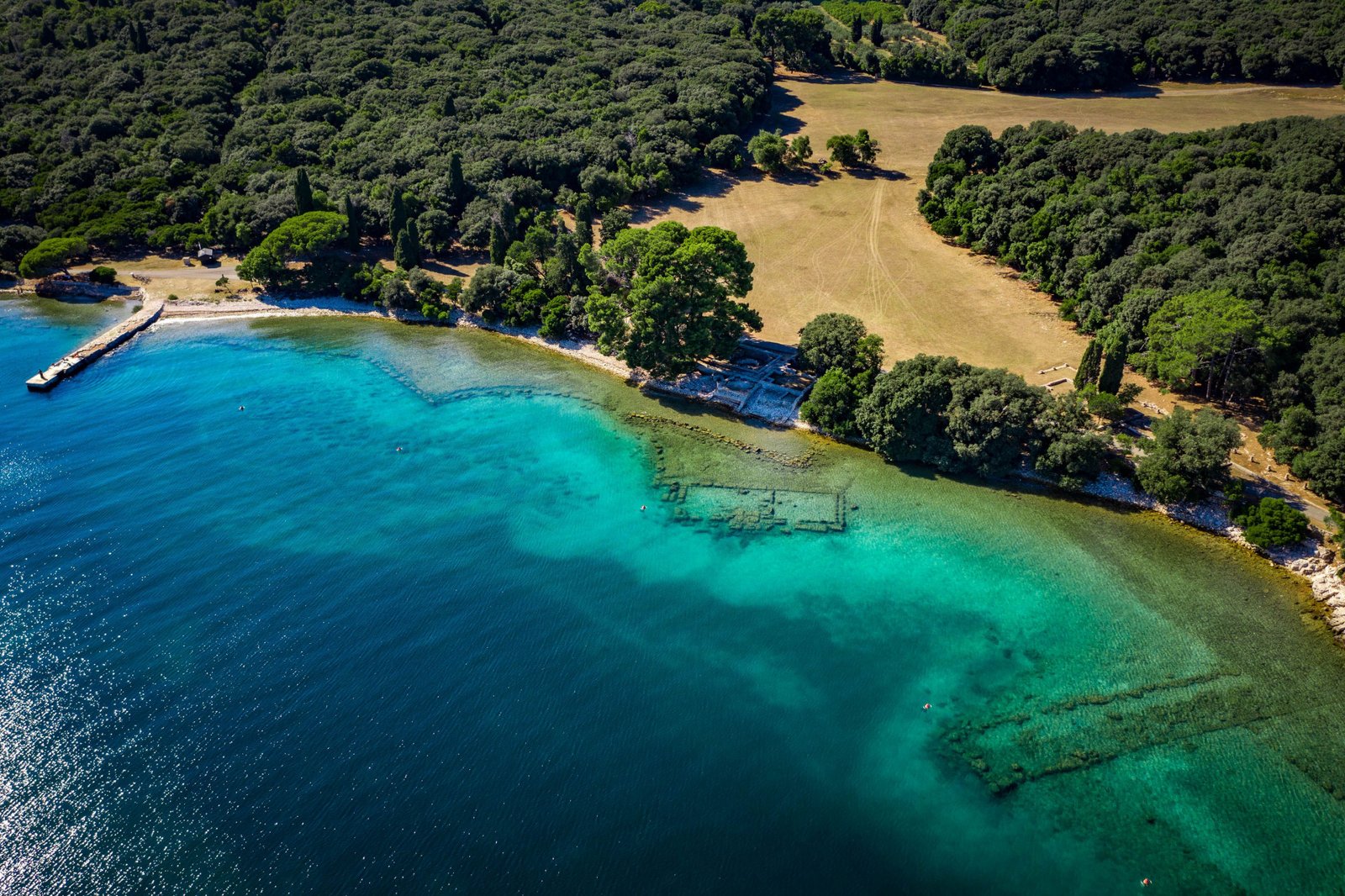
A short boat ride from Pula takes you to Brijuni National Park, an archipelago of 14 islands renowned for their natural beauty, archaeological sites, and wildlife. The park was once the summer residence of Yugoslav leader Josip Broz Tito. Today, visitors can explore its lush landscapes, ancient Roman villas, and even a safari park.
Nestled just off the coast of Pula, Brijuni National Park is an enchanting archipelago that offers a perfect blend of natural beauty, rich history, and cultural significance. Comprising 14 stunning islands, Brijuni is a paradise for nature lovers, history enthusiasts, and travelers seeking a serene escape. From pristine landscapes and exotic wildlife to ancient ruins and fascinating tales of famous visitors, a trip to Brijuni National Park promises a truly unforgettable experience.
A Natural Wonderland
Brijuni’s breathtaking landscapes feature lush greenery, crystal-clear waters, and diverse flora and fauna. The park is home to an extraordinary variety of Mediterranean vegetation, including centuries-old olive trees, aromatic herbs, and vibrant wildflowers. Wildlife lovers will be delighted to encounter deer, peacocks, rabbits, and even exotic animals such as zebras and elephants, which were gifted to the park during the era of former Yugoslav President Josip Broz Tito.
The marine life surrounding Brijuni is equally impressive, with vibrant coral reefs, sea sponges, and schools of fish thriving in the protected waters. For those interested in snorkeling or diving, the park offers an underwater archaeological trail where visitors can explore sunken Roman ruins beneath the Adriatic Sea.
A Journey Through History
Brijuni National Park is not just a natural wonder but also a treasure trove of history. The islands have been inhabited since prehistoric times, and their past is reflected in the numerous archaeological sites and historical landmarks scattered throughout the park.
- Roman Ruins: One of the most remarkable sites is the ruins of a Roman villa in Verige Bay, dating back to the 1st century AD. This ancient complex once served as a luxurious seaside retreat, complete with temples, baths, and grand courtyards.
- Byzantine and Venetian Influence: Over the centuries, Brijuni has been influenced by various civilizations, including the Byzantines and Venetians, whose architectural and cultural imprints remain visible today.
- Tito’s Legacy: Perhaps the most intriguing chapter in Brijuni’s history is its connection to Josip Broz Tito, who used the islands as his personal retreat for over three decades. World leaders, Hollywood stars, and dignitaries, including Queen Elizabeth II and Sophia Loren, were frequent visitors. Today, the Tito Museum showcases photographs, gifts, and artifacts from this fascinating period.
Things to Do in Brijuni National Park
Brijuni offers a wide range of activities for visitors of all interests:
- Guided Safari Tours: Explore the Brijuni Safari Park, home to various exotic animals roaming freely in a picturesque setting.
- Biking and Hiking: Rent a bicycle or take a scenic walk along well-maintained trails that lead through olive groves, meadows, and historical sites.
- Golfing with a View: Brijuni features a unique golf course, where players can enjoy a round of golf amidst stunning natural surroundings.
- Boat Excursions: Take a boat tour around the islands to fully appreciate the archipelago’s beauty from the sea.
- Educational Exhibits: Visit the Brijuni Natural History Museum and the Archaeological Museum to deepen your understanding of the park’s ecological and historical significance.
How to Visit Brijuni National Park
- Getting There: The park is accessible via a short boat ride from the coastal town of Fažana, just a 15-minute drive from Pula. Regular boat excursions are available throughout the day.
- Best Time to Visit: Spring and summer offer the best weather for exploring, but autumn provides a quieter, equally stunning experience.
- Entry Fees: Entrance fees vary depending on the type of tour chosen, with guided tours being a popular option for first-time visitors.
7. Indulge in Istrian Cuisine and Wine
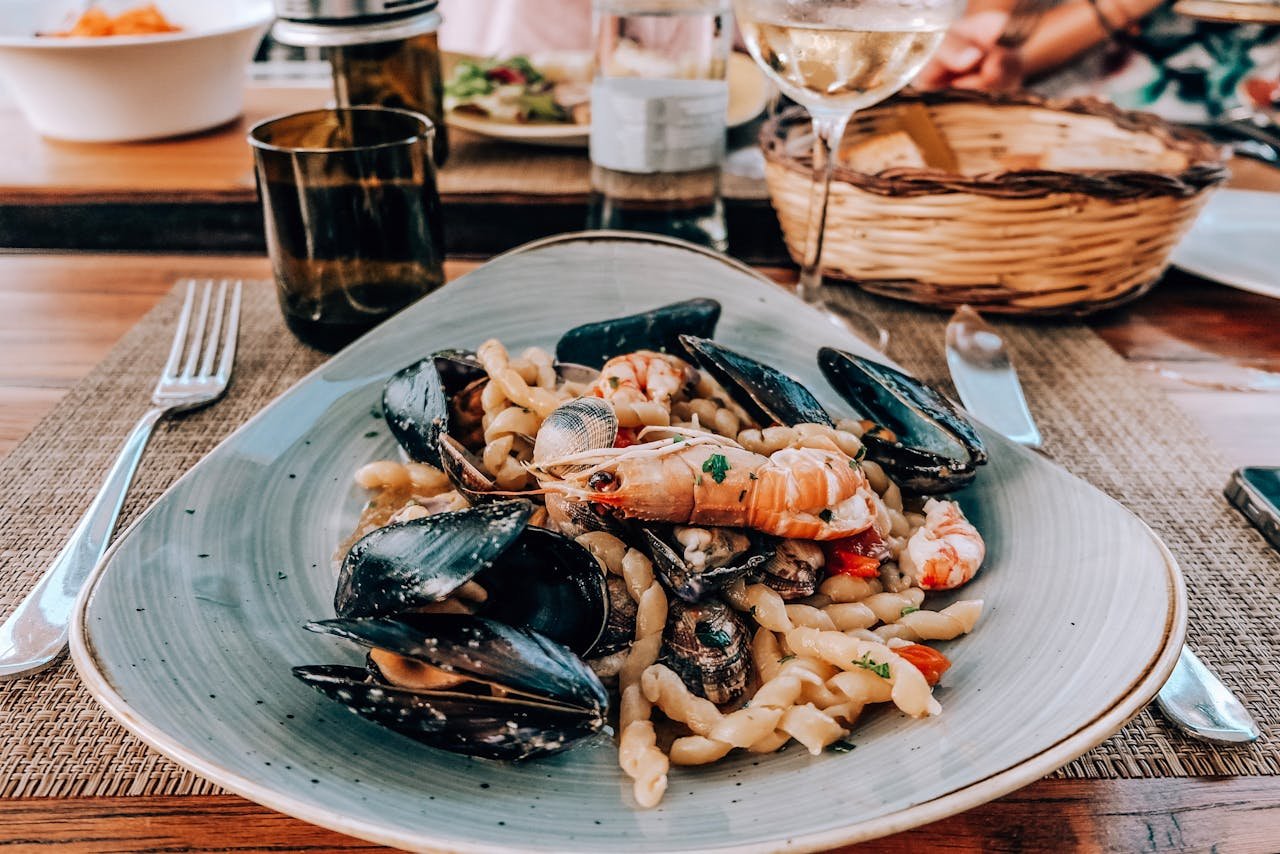
Istria is famous for its gastronomic delights, and Pula is no exception. Try truffle-infused dishes, fresh seafood, and locally-produced olive oil. Pair your meal with a glass of Malvazija or Teran wine, two of the region’s best-known varieties. Some top restaurants to try include Konoba Batelina, Farabuto, and Milan Restaurant.
Pula, a vibrant coastal city in Croatia’s Istrian Peninsula, is not only known for its ancient Roman architecture and stunning beaches but also for its rich culinary heritage. Influenced by Mediterranean, Italian, and Central European flavors, Istrian cuisine offers an exquisite gastronomic experience that is best complemented by the region’s world-class wines. Whether you’re savoring fresh seafood, indulging in handmade pasta, or tasting award-winning olive oils and truffles, Pula is a true paradise for food and wine lovers.
A Taste of Istrian Cuisine
The cuisine of Istria is deeply rooted in its natural surroundings, utilizing fresh, high-quality ingredients from the land and sea. Here are some of the must-try traditional dishes in Pula:
- Fuži and Pljukanci – These handmade Istrian pastas are often served with truffle-based sauces, game meat, or creamy seafood toppings. The combination of pasta and locally sourced ingredients creates an unforgettable dining experience.
- Istrian Truffles – Istria is renowned for its black and white truffles, particularly from the forests of Motovun. These rare delicacies are often shaved over pasta, risottos, or omelets to enhance their rich and earthy flavors.
- Brodet (Istrian Fish Stew) – A traditional fisherman’s dish made with a mix of fresh Adriatic fish, shellfish, and aromatic herbs, slowly cooked in a flavorful tomato and white wine sauce.
- Peka – A slow-cooked dish featuring meat (often lamb, veal, or octopus) and vegetables, cooked under a bell-shaped lid covered in hot coals, resulting in tender, smoky flavors.
- Maneštra – A hearty Istrian soup made with beans, cured meats, and seasonal vegetables, reminiscent of Italian minestrone.
- Grilled Adriatic Seafood – Pula’s coastal location ensures an abundance of fresh fish, squid, and shellfish, often simply grilled with olive oil, garlic, and parsley for a true taste of the sea.
- Pršut and Cheese – Istrian pršut (air-dried ham) is a delicacy often paired with local cheeses and olives, making it an ideal starter for any meal.
Istrian Wines: A Perfect Pairing
No culinary journey in Pula is complete without exploring Istrian wines, which have gained international recognition for their exceptional quality. The region’s diverse terroir, mild climate, and dedication to winemaking produce some of Croatia’s finest wines. Here are some standout varieties:
- Malvazija Istarska – The flagship white wine of Istria, Malvazija is known for its fruity aroma, crisp acidity, and floral notes, making it a perfect match for seafood dishes.
- Teran – A bold and full-bodied red wine with intense berry flavors, spice, and earthy undertones, ideal for pairing with truffle dishes, grilled meats, and game.
- Refošk – Another robust red wine with deep flavors and strong tannins, often enjoyed with aged cheeses and rich stews.
- Muškat Momjanski – A delightful sweet wine with a fragrant bouquet, often served as a dessert wine or paired with local pastries.
- Rosé Wines – Istria’s rosé wines are crisp and refreshing, making them an excellent choice for warm summer evenings by the sea.
Where to Dine and Wine in Pula
Pula boasts a vibrant food scene with a variety of restaurants, konobas (traditional taverns), and wine bars where you can sample the best of Istrian cuisine. Here are a few top recommendations:
- Konoba Batelina – A family-run seafood restaurant famous for its fresh daily catch and creative fish-based dishes.
- Vodnjanka – A cozy spot offering traditional Istrian recipes with a modern twist, using locally sourced ingredients.
- Farabuto – A charming restaurant known for its elegant Mediterranean dishes and expertly paired wines.
- Konoba Boccaporta – A must-visit for authentic Istrian flavors, including homemade pasta, truffles, and slow-cooked meats.
- Wine Bars – Head to Enoteca Istriana or Vina Benazić for an excellent selection of local wines and a relaxed tasting experience.
Olive Oil and Truffle Tastings
In addition to its exceptional wines, Istria is also celebrated for its premium olive oils. Many local producers offer guided tastings, where visitors can sample different varieties and learn about traditional olive oil production. Similarly, truffle-hunting excursions provide an exciting opportunity to experience the search for these rare culinary treasures firsthand.
8. Visit the Aquarium Pula
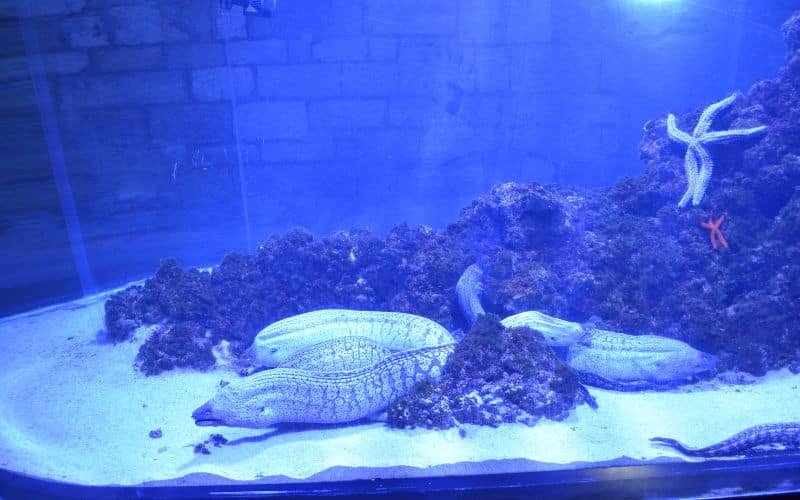
For a family-friendly activity, visit Aquarium Pula, housed in a historic Austro-Hungarian fortress. The aquarium showcases marine life from the Adriatic Sea and features conservation programs for endangered species. The rooftop offers breathtaking panoramic views of Pula’s coastline.
Nestled within the historic Fort Verudela, Aquarium Pula is one of Croatia’s most intriguing marine attractions. Combining rich history with marine conservation, this unique aquarium offers visitors an educational and immersive journey through the diverse underwater world of the Adriatic Sea and beyond. Whether you’re a marine enthusiast, a family with children, or a traveler looking to explore something beyond Pula’s ancient ruins, the Aquarium Pula is a must-visit destination.
A Unique Setting: Fort Verudela
What sets Aquarium Pula apart from other marine centers is its extraordinary location. Housed within a 19th-century Austro-Hungarian fortress, the aquarium seamlessly blends historical architecture with modern exhibits. The stone walls, tunnels, and chambers of Fort Verudela provide a truly atmospheric setting, making the visit as much about history as it is about marine life.
Marine Life and Exhibits
Aquarium Pula is home to a vast array of marine species, offering visitors a chance to explore the underwater biodiversity of the Adriatic Sea, as well as exotic species from tropical waters and freshwater ecosystems. Some of the highlights include:
- Adriatic Fish and Marine Creatures – Discover local marine species, including groupers, moray eels, seahorses, and colorful reef fish.
- Shark Tank – Observe dogfish sharks and other fascinating species up close in a large, specially designed tank.
- Sea Turtle Rescue Center – One of the most significant aspects of Aquarium Pula is its commitment to marine conservation. The aquarium operates Croatia’s only sea turtle rescue center, dedicated to rehabilitating injured turtles before releasing them back into the wild.
- Tropical and Freshwater Aquariums – Explore diverse ecosystems with exotic species such as piranhas, clownfish, and coral reef inhabitants.
- Jellyfish and Seahorse Exhibits – Learn about the mesmerizing movements and unique biology of these delicate marine creatures.
- Interactive Touch Pool – Perfect for children, this exhibit allows visitors to get hands-on with starfish and other small sea creatures in a safe and educational environment.
Conservation and Educational Programs
Beyond being a tourist attraction, Aquarium Pula plays a vital role in marine conservation. Through various research programs and rescue efforts, the aquarium helps protect endangered species, particularly sea turtles and seahorses. Visitors can learn about marine ecosystems, the importance of sustainable fishing, and the impact of climate change on ocean life through engaging educational displays and programs.
Panoramic Views from the Fortress
For those looking to capture stunning views of Pula and the Adriatic coastline, the aquarium offers access to the rooftop of Fort Verudela. The panoramic lookout provides breathtaking vistas, making it a great spot for photography and relaxation after exploring the exhibits.
Practical Information for Visitors
- Location: Aquarium Pula is located within Fort Verudela, a short drive from Pula’s city center.
- Opening Hours: The aquarium is open year-round, with extended hours during the summer season.
- Tickets: Entry fees vary depending on age, with discounts available for children, students, and groups.
- Best Time to Visit: Mornings and late afternoons are ideal to avoid peak crowds, especially during the summer months.
- How to Get There: The aquarium is easily accessible by car, public transport, or even by bike along Pula’s scenic coastal routes.
9. Catch a Sunset at Cape Kamenjak
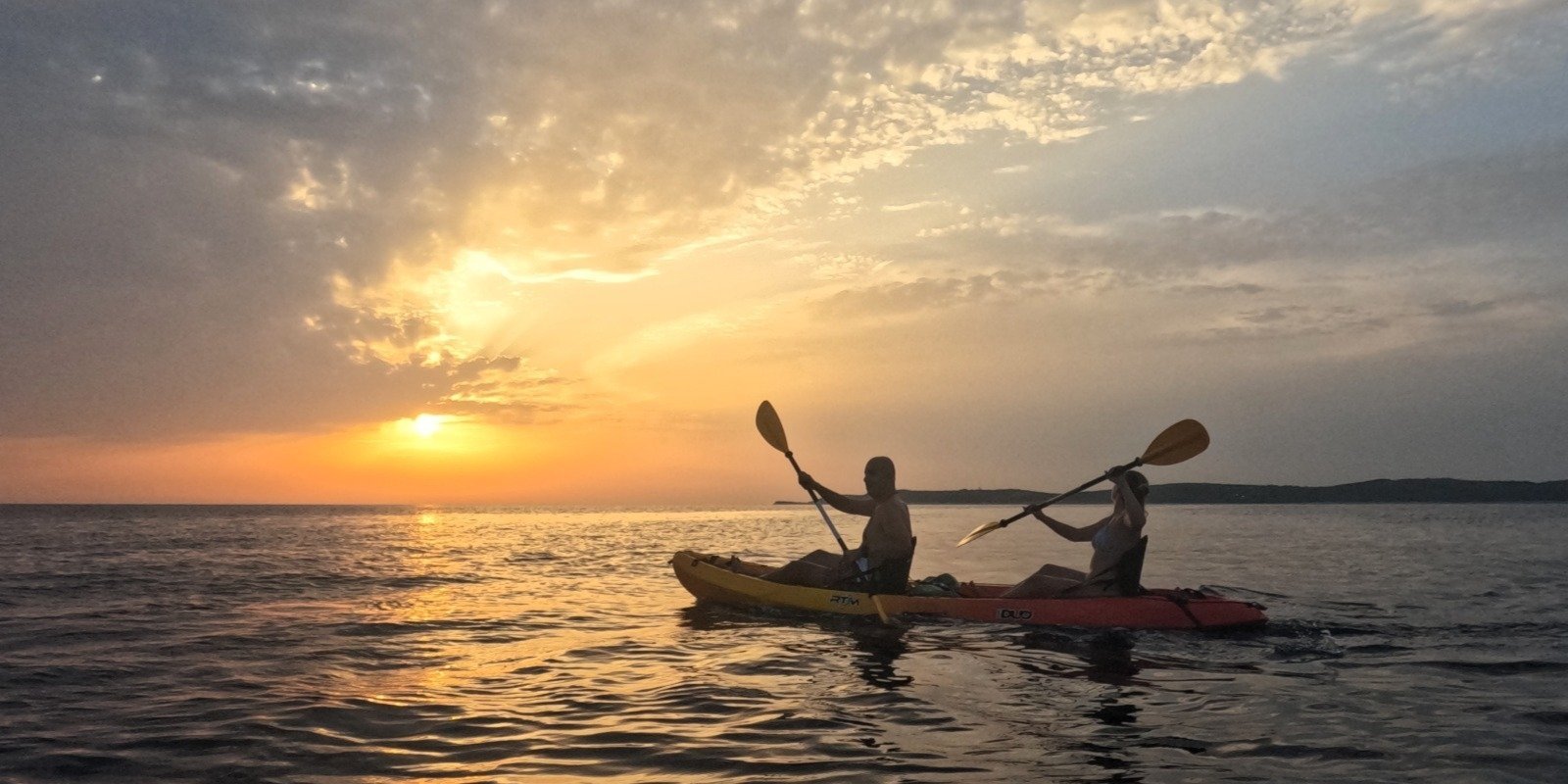
Located just south of Pula, Cape Kamenjak is a rugged natural park with spectacular cliffs, secluded beaches, and scenic trails. It’s one of the best spots to watch the sunset over the Adriatic. Adventure seekers can try cliff diving, biking, or kayaking in the park’s pristine surroundings.
For those seeking a truly mesmerizing sunset experience, Cape Kamenjak, located at the southernmost tip of the Istrian Peninsula, offers an unforgettable spectacle. With its rugged coastline, crystal-clear waters, and untouched natural beauty, this protected nature park is one of Croatia’s most scenic spots to witness the sun dip below the horizon. Whether you’re a nature lover, a photographer, or a traveler in search of serenity, watching a sunset at Cape Kamenjak is an experience that will stay with you long after your visit.
Why Cape Kamenjak?
Cape Kamenjak is a paradise for adventurers and nature enthusiasts, boasting dramatic limestone cliffs, hidden coves, and panoramic views of the Adriatic Sea. Unlike the more commercialized areas of Croatia’s coastline, this 15-mile-long nature reserve remains untouched, offering a raw and immersive experience. The rugged charm of Kamenjak, combined with its tranquil atmosphere, makes it an ideal location to enjoy the simple yet powerful beauty of a sunset.
The Best Spots to Watch the Sunset
There are numerous stunning viewpoints across Cape Kamenjak to witness the golden hues of the setting sun. Here are some of the best spots:
- Safari Bar – Perched on the cliffs, this rustic, jungle-themed bar provides a laid-back setting where visitors can relax with a drink while enjoying an uninterrupted view of the horizon.
- Porer Lighthouse Viewpoint – Positioned on a small islet just off the coast, the Porer Lighthouse adds a picturesque element to the sunset, creating a postcard-perfect moment.
- Mala Kolumbarica Cliffs – For a more adventurous experience, head to the cliffs at Mala Kolumbarica, where thrill-seekers often engage in cliff diving before settling in to watch the sun fade into the sea.
- Secluded Coves – If you prefer a private moment, explore the many hidden bays and coves along the coastline, where you can enjoy the sunset in peaceful solitude.
Activities to Enhance the Experience
Catching the sunset at Cape Kamenjak isn’t just about watching the sky change colors—it’s about immersing yourself in nature and making the most of this breathtaking location. Consider these activities before or after sunset:
- Swimming and Snorkeling – The clear waters make for a perfect pre-sunset swim, allowing you to explore the vibrant marine life.
- Cycling or Hiking – Kamenjak offers scenic trails for cycling and hiking, allowing you to discover the diverse landscape before settling down for sunset.
- Kayaking and Paddleboarding – Rent a kayak or paddleboard and enjoy a unique perspective of the sunset from the water.
- Photography – Whether you're a professional photographer or just capturing memories on your phone, the contrast of the golden sky against the deep blue sea provides endless photo opportunities.
Best Time to Visit
While sunsets at Cape Kamenjak are spectacular year-round, the best time to visit is spring through early autumn (April–October) when the weather is warm, and the skies are clear. Summer months offer the most vibrant hues, while September and October provide a more tranquil experience with fewer crowds.
How to Get There
- By Car – Cape Kamenjak is easily accessible from Pula (about a 30-minute drive). There is an entrance fee for vehicles, as it is a protected area.
- By Bike – Cycling from Premantura (the nearest village) is a great way to explore the area before reaching your sunset spot.
- By Boat – Private boat tours from Pula and nearby towns often include sunset excursions to Cape Kamenjak.
10. Attend Festivals and Cultural Events
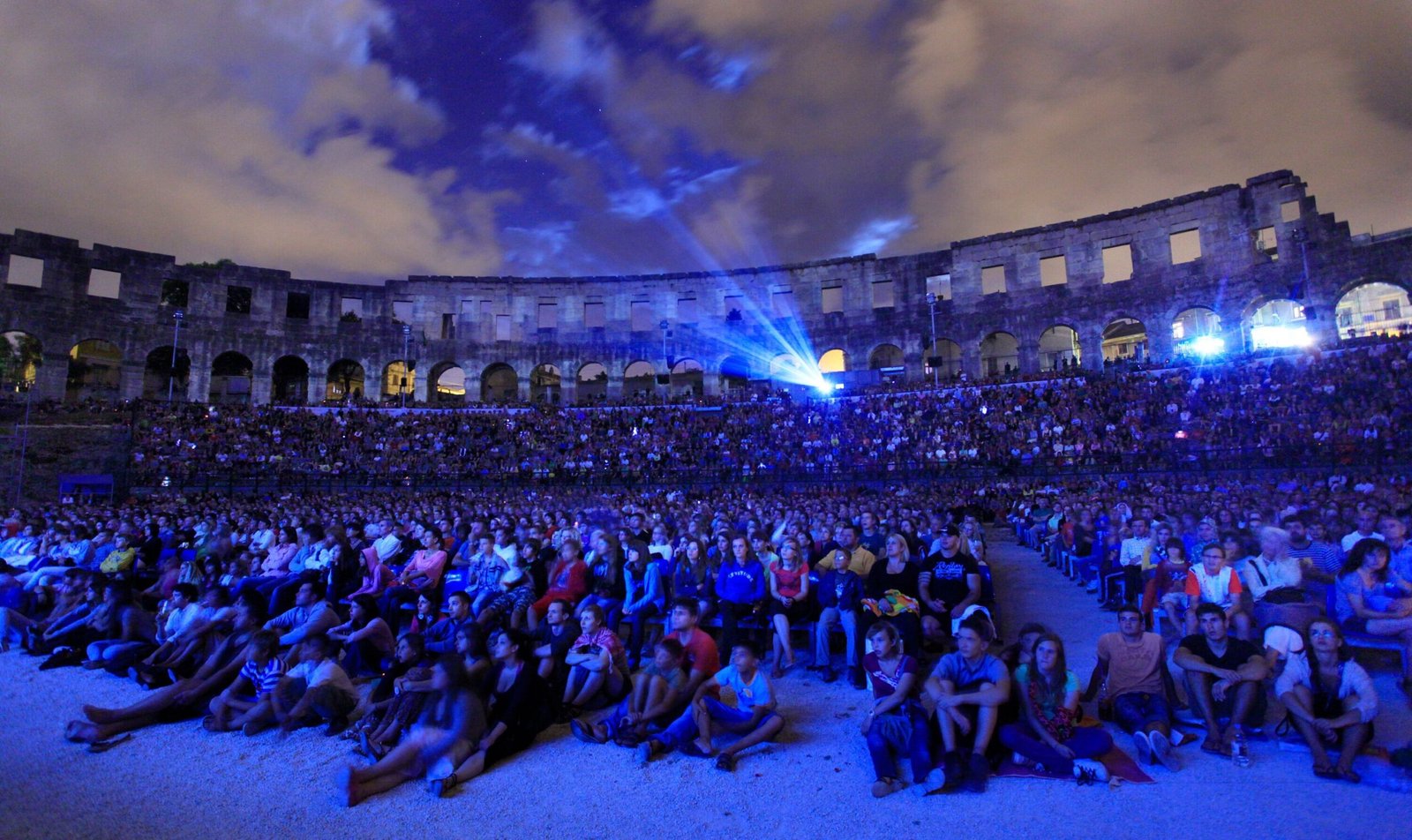
Pula is a city that loves its festivals. The Pula Film Festival, held in the Pula Arena, is one of Croatia’s most prestigious cultural events. Music lovers can enjoy the Seasplash Festival or Outlook Festival, both featuring international artists in stunning coastal settings.
Pula Film Festival: A Cinematic Experience in the Roman Arena
One of the most iconic cultural events in Croatia, the Pula Film Festival, takes place in the breathtaking Pula Arena, a 2,000-year-old Roman amphitheater. Held annually in July, this prestigious festival showcases a mix of Croatian and international films, premiering everything from independent productions to major cinematic releases.
- Venue: Pula Arena
- Best For: Film lovers, history enthusiasts, and anyone looking for a unique movie-watching experience under the stars
- What to Expect: Open-air screenings, red-carpet events, film workshops, and discussions with directors and actors
Outlook and Dimensions Festivals: Electronic and Bass Music Extravaganza
Pula has become a hotspot for electronic music lovers thanks to Outlook Festival and Dimensions Festival, two internationally renowned events that celebrate bass, house, techno, and reggae music. Set against the stunning backdrop of Fort Punta Christo, these festivals offer an electrifying experience with world-class DJs and artists.
- Venue: Fort Punta Christo, beaches, and boats around Pula
- Best For: Electronic music enthusiasts and festivalgoers seeking an unforgettable party atmosphere
- What to Expect: Beach parties, boat parties, underground raves, and legendary DJ performances
Seasplash Festival: Reggae, Dub, and More
If you’re a fan of reggae, dub, ska, and world music, Seasplash Festival is an event you shouldn’t miss. Set along the Adriatic coast, this festival delivers an amazing blend of live music, dance performances, and artistic workshops, creating a laid-back and inclusive atmosphere.
- Venue: Various coastal locations around Pula
- Best For: Fans of relaxed, beachside music festivals
- What to Expect: Live reggae and dub performances, drum circles, and workshops in a vibrant seaside setting
Pula Superiorum: A Journey Through Ancient Rome
History comes alive during Pula Superiorum, a festival that transports visitors back to Roman times. This event, held in the city’s historic sites, features gladiator battles, traditional Roman feasts, street performances, and cultural exhibitions.
- Venue: Pula Arena and the city center
- Best For: History buffs and families looking for an interactive cultural experience
- What to Expect: Gladiator shows, ancient craft fairs, traditional Roman food tastings, and reenactments of historical events
Spectacvla Antiqva: Gladiators in the Arena
For an even deeper dive into Pula’s Roman heritage, Spectacvla Antiqva offers weekly gladiator fights and Roman-themed performances in the iconic Pula Arena during the summer months. The event recreates the ancient spectacles once held in this grand amphitheater.
- Venue: Pula Arena
- Best For: Families, history lovers, and anyone intrigued by ancient Rome
- What to Expect: Gladiator battles, interactive experiences, and a journey into Pula’s Roman past
Istria Gourmet Festival and Wine Events
Food and wine lovers can experience Istria’s rich culinary heritage through various gourmet festivals and wine-tasting events in and around Pula. These events highlight the region’s finest truffles, olive oils, cheeses, and wines.
- Venue: Various restaurants, vineyards, and town squares
- Best For: Foodies, wine enthusiasts, and those wanting to explore Istrian gastronomy
- What to Expect: Truffle tastings, wine pairings, cooking workshops, and local gourmet delights
Lighting Giants: A Unique Visual Spectacle
An artistic event unlike any other, Lighting Giants transforms the cranes of Uljanik Shipyard into a mesmerizing light show. Every night, these industrial giants illuminate the Pula skyline with a dynamic display of colors and patterns, showcasing the city’s modern artistic vision.
- Venue: Uljanik Shipyard
- Best For: Photography enthusiasts and lovers of contemporary art
- What to Expect: A spectacular light show set against Pula’s waterfront

